Related Research Articles

Glastonbury is a town and civil parish in Somerset, England, situated at a dry point on the low-lying Somerset Levels, 23 miles (37 km) south of Bristol. The town, which is in the Mendip district, had a population of 8,932 in the 2011 census. Glastonbury is less than 1 mile (2 km) across the River Brue from Street, which is now larger than Glastonbury.

Glastonbury is a town in Hartford County, Connecticut, United States, formally founded in 1693 and first settled in 1636. The town was named after Glastonbury in Somerset, England. Glastonbury is located on the banks of the Connecticut River, 7 miles (11 km) southeast of Hartford. The town center is defined by the U.S. Census Bureau as a census-designated place (CDP). The population was 35,159 at the 2020 census.
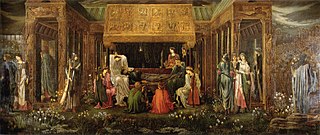
Avalon is a mythical island featured in the Arthurian legend that first appeared in Geoffrey of Monmouth's influential 1136 Historia Regum Britanniae as a place of magic where King Arthur's sword Excalibur was made and later where Arthur was taken to recover from being gravely wounded at the Battle of Camlann. Since then, the island has become a symbol of Arthurian mythology, similar to Arthur's castle of Camelot.
Glastonbury Tor is a hill near Glastonbury in the English county of Somerset, topped by the roofless St Michael's Tower, a Grade I listed building. The entire site is managed by the National Trust and has been designated a scheduled monument. The Tor is mentioned in Celtic mythology, particularly in myths linked to King Arthur, and has several other enduring mythological and spiritual associations.
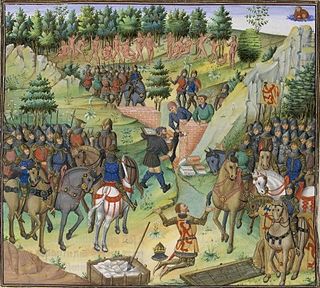
Gog and Magog appear in the Hebrew Bible and the Quran as individuals, tribes, or lands. In Ezekiel 38, Gog is an individual and Magog is his land; in Genesis 10, Magog is a man and eponymous ancestor of a nation, but no Gog is mentioned; by the time of Revelation 20:8 Jewish tradition had long since changed Ezekiel's "Gog from Magog" into "Gog and Magog".

Glastonbury Abbey was a monastery in Glastonbury, Somerset, England. Its ruins, a grade I listed building and scheduled ancient monument, are open as a visitor attraction.

The Sweet Track is an ancient trackway, or causeway, in the Somerset Levels, England, named after its finder, Ray Sweet. It was built in 3807 BC and is the second-oldest timber trackway discovered in the British Isles, dating to the Neolithic. It is now known that the Sweet Track was predominantly built along the course of an earlier structure, the Post Track.
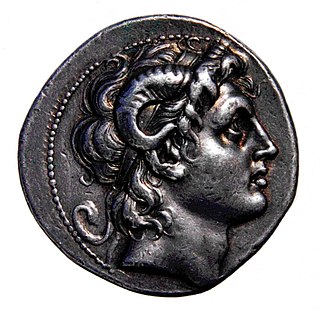
The story of Dhul-Qarnayn, is mentioned in the Quran.

The Glastonbury thorn is a form of common hawthorn, Crataegus monogyna 'Biflora', found in and around Glastonbury, Somerset, England. Unlike ordinary hawthorn trees, it flowers twice a year, the first time in winter and the second time in spring. The trees in the Glastonbury area have been propagated by grafting since ancient times. The tree is also widely called the holy thorn, though this term strictly speaking refers to the original (legendary) tree.
Thatchers Cider is a family-owned cider maker in Sandford, North Somerset, England.

The Gog Magog Hills are a range of low chalk hills, extending for several miles to the southeast of Cambridge in England. The highest points are situated either side of the A1307 Babraham Road, and are marked on Ordnance Survey 1:25000 maps as "Telegraph Clump" at 75 m (246 ft), Little Trees Hill and Wandlebury Hill, both at 74 m (243 ft). The area as a whole is undefined but is roughly the elevated area lying north west of the 41 m (135 ft) col at Worsted Lodge.
Gog may refer to:
Geoffrey Thomas Leslie Ashe was a British cultural historian and lecturer, known for his focus on King Arthur.

Glastonbury Lake Village was an Iron Age village, situated on a crannog or man made island in the Somerset Levels, near Godney, some 3 miles (5 km) north west of Glastonbury in the southwestern English county of Somerset. It has been designated as a scheduled monument.
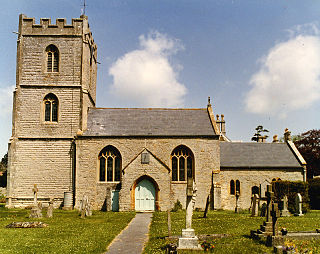
Cossington is a village and civil parish close to Woolavington and 5 miles (8 km) north of Bridgwater, in the Sedgemoor district in Somerset, England. The village lies on the north side of the Polden Hills.
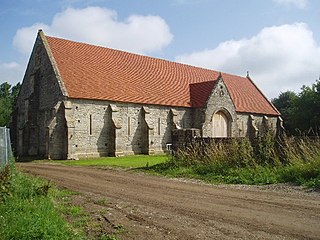
The Tithe Barn at Cumhill Farm in Pilton, Somerset, England, was built in the 14th century as a tithe barn to hold produce for Glastonbury Abbey. It is a Grade I listed building and Scheduled Ancient Monument.

Gogmagog was a legendary giant in Welsh and later English mythology. According to Geoffrey of Monmouth's Historia Regum Britanniae, he was a giant inhabitant of Albion, thrown off a cliff during a wrestling match with Corineus. Gogmagog was the last of the Giants found by Brutus and his men inhabiting the land of Albion.

Ponter's Ball Dyke is a linear earthwork located near Glastonbury in Somerset, England. It crosses, at right angles, an ancient road that continues on to the Isle of Avalon. It consists of an embankment with a ditch on the east side. It is built across the ridge of land between Glastonbury and West Pennard. Both ends of the ditch and dyke disappear into moorland, formerly swamps.

The Abbot's Kitchen is a mediaeval octagonal building that served as the kitchen at Glastonbury Abbey in Glastonbury, Somerset, England. It is a Grade I listed building. The abbot's kitchen has been described as "one of the best preserved medieval kitchens in Europe". The stone-built construction dates from the 14th century and is one of a very few surviving mediaeval kitchens in the world.
There were several origin stories of the Gothic peoples recorded by Latin and Greek authors in late antiquity, and these are relevant not only to the study of literature, but also by historians seeking evidence of real historical events involving the Goths and other peoples mentioned in these stories.
References
- 1 2 Glastonbury Pilgrim Reception Centre: Gog & Magog - Glastonbury Pilgrim Reception Centre, accessdate: April 28, 2017
- ↑ Arthur Eedle. Albion Restored. Lulu.com. p. 166. ISBN 978-1-291-32325-2.
- ↑ The Guardian: Ancient Glastonbury oak tree known as Gog damaged in fire | UK news | The Guardian, accessdate: April 28, 2017
- ↑ Gailand MacQueen (2005). The Spirituality of Mazes and Labyrinths. Wood Lake Publishing Inc. p. 106. ISBN 978-1-896836-69-0.
- ↑ Somerset Live: A 2000-year-old Glastonbury oak tree called Gog has gone up in flames | Somerset Live, accessdate: April 28, 2017
- ↑ Somerset Live: People are crying as they visit 2,000-year-old tree Gog that went up in flames near Glastonbury | Somerset Live, accessdate: April 28, 2017